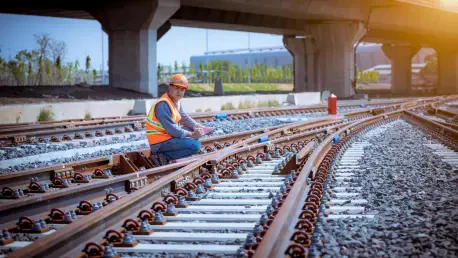Imagine a rail network battered by relentless floods, scorching heatwaves, and unpredictable storms, yet still running seamlessly, ensuring passengers and goods move without delay. This is the pressing challenge facing Europe’s rail industry as climate change intensifies, disrupting infrastructure and threatening sustainable transportation. The Intelligent Rail Summit, held on November 4–5 at the breathtaking Lake Bled in Slovenia, tackled this very issue under the theme “Climate-Proof Rail, Driven by Data.” Bringing together industry leaders, tech innovators, and experts from across the continent, the event spotlighted how data-driven solutions can fortify rail systems against environmental threats. This gathering marked a turning point, offering actionable insights into merging smart technology with rail operations to build resilience.
Setting the Scene: A Summit Amid Climate Challenges
Nestled in Slovenia’s scenic landscape, Lake Bled provided more than just a stunning backdrop for the summit. The location carried symbolic weight, as Slovenia has faced severe climate impacts, with significant portions of its rail network damaged by floods in recent years. This real-world context underscored the urgency of the discussions, making the venue a fitting stage for exploring solutions to environmental volatility. The event drew a diverse crowd of professionals eager to address how rail infrastructure—vital for Europe’s green transport goals—can adapt to escalating weather extremes.
The theme of data as a driver for climate resilience resonated throughout the summit’s agenda. Attendees recognized that traditional methods of managing rail systems fall short in today’s unpredictable conditions. The focus shifted toward harnessing artificial intelligence, predictive analytics, and real-time monitoring to anticipate and mitigate risks, setting a bold direction for the industry’s future.
Summit Highlights: Data at the Core of Rail Adaptation
The two-day event featured a robust lineup of activities, from expert talks to hands-on demonstrations, all centered on integrating data into rail operations. Key discussions revealed how digital tools are no longer optional but essential for maintaining service continuity amid climate disruptions. The summit painted a clear picture: data-driven innovation is transforming how rail networks prepare for and recover from environmental challenges.
A standout theme was the shift from reactive to proactive strategies. Speakers and participants emphasized that waiting for disasters to strike is no longer viable. Instead, technologies like sensor-based monitoring and AI analytics are enabling rail operators to detect vulnerabilities early, ensuring infrastructure remains robust even under stress. This proactive mindset emerged as a cornerstone of the event’s takeaways.
Expert Insights: Pioneering Solutions for Infrastructure
Keynote speeches delivered cutting-edge perspectives on embedding resilience into rail systems. Matjaž Kranjc of SŽ-Infrastruktura shared Slovenia’s journey of rebuilding after devastating floods, highlighting how predictive analytics helped prioritize maintenance and reduce downtime. His insights grounded the discussion in practical, local experiences, showing the tangible benefits of smart technology.
Javier De La Cruz from CAF also captivated the audience with a deep dive into sensor-driven data applications. His presentation showcased how digital tools enhance risk detection, allowing operators to address issues before they escalate. These expert talks reinforced that data isn’t just a tool—it’s a fundamental shift in how rail systems are managed, offering a blueprint for widespread adoption.
Panel Debates: Navigating the Path to Digital Integration
Panel discussions brought together diverse voices, including representatives from Altametris and Rail Logistics Europe, to debate the complexities of adopting digital solutions. A key point of contention was overcoming cultural resistance within the industry, as many organizations hesitate to move away from established practices. The panels stressed that collaboration among stakeholders is critical to breaking down these barriers.
Another focal point was scaling pilot projects into standard operations. Experts acknowledged that while small-scale successes with AI and monitoring systems are promising, broader implementation faces logistical hurdles. These debates provided a balanced view, weighing the immense potential of technology against the real-world challenges of integration, and urging a unified approach to progress.
Hands-On Learning: Workshops and Real-World Applications
Interactive workshops offered participants a chance to engage directly with data-driven tools, exploring their practical impact on rail resilience. These sessions focused on scalable solutions, teaching attendees how to apply analytics and monitoring in their own contexts. The emphasis on actionable learning ensured that theoretical concepts translated into usable strategies.
A highlight was the site visit to voestalpine’s checkpoint system in Slovenia, where attendees witnessed sensor-based, real-time fault detection in action. This firsthand look at cutting-edge technology demonstrated its role in maintaining infrastructure under stress. Such experiences bridged the gap between discussion and implementation, inspiring participants to envision similar advancements in their regions.
Tech Innovations: Showcasing the Future of Rail Safety
Technology exhibitions stole the show, with companies like SNCF’s Altametris unveiling industrial-scale 3D data inspections that streamline maintenance checks. These innovations showcased how automation reduces human error and boosts efficiency, directly addressing climate-related risks. The displays underscored the transformative power of digital tools in safeguarding rail operations.
Slovenia’s Institute of Traffic and Transport also presented AI-driven risk detection systems, illustrating their potential to predict and prevent disruptions. These showcases highlighted a clear trend: robotics and automated monitoring are redefining safety standards. By linking these advancements to climate resilience, the exhibitions offered a glimpse into a future where rail networks withstand environmental pressures with unprecedented precision.
Reflecting on a Milestone Event
The Intelligent Rail Summit at Lake Bled proved to be a landmark occasion, uniting the rail industry in a shared mission to combat climate challenges through data innovation. Over two days, it became evident that tools like AI and predictive analytics hold the key to stronger, more adaptive infrastructure. The event’s blend of expert insights, debates, hands-on learning, and tech displays created a comprehensive platform for change.
Looking back, the summit sparked vital conversations that laid the groundwork for actionable next steps. Industry players left with a renewed commitment to integrate smart technologies, focusing on pilot expansions and cross-border partnerships from this year to 2027. Beyond immediate solutions, the event ignited a broader vision—encouraging rail operators to advocate for policy support and funding to make digital transformation accessible. This gathering in Slovenia not only addressed today’s urgent needs but also planted seeds for a sustainable, resilient rail network across Europe in the years ahead.









